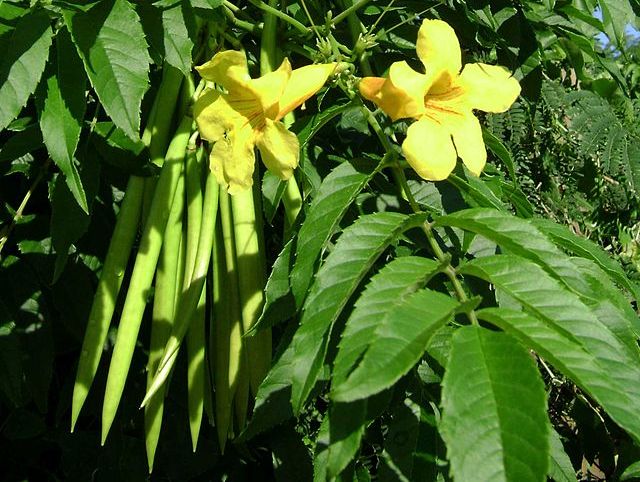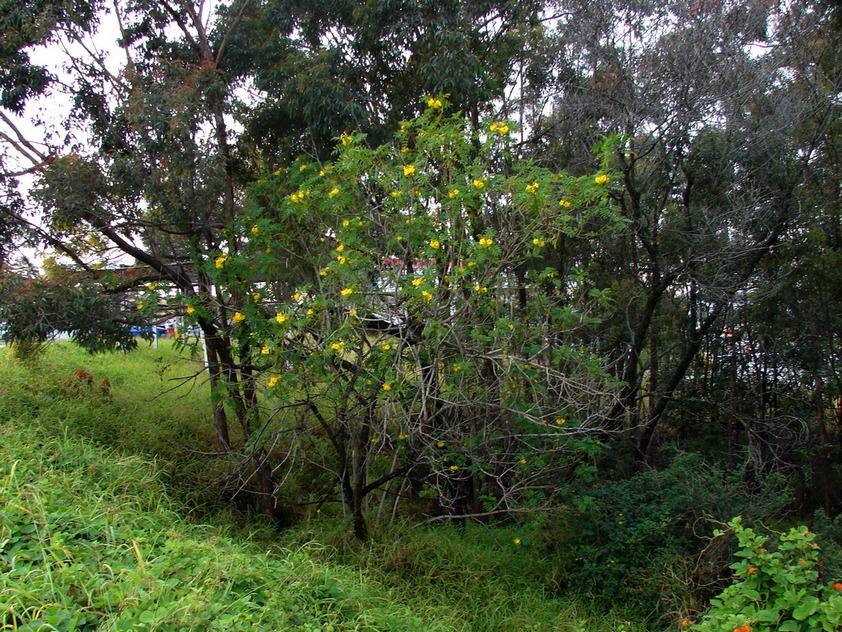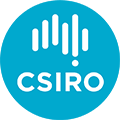Yellow bells
Yellow bells (Tecoma stans) is a shrub or small tree that is invasive in coastal areas of NSW. It can produce dense stands that outcompete natural vegetation. Yellow bells was classified as a secondary priority weed for biocontrol as part of the prioritisation process undertaken in the project. It is however, a weed that is of increasing concern in NSW and included in several Local Land Services Regional Weed Plans. The Trust decided to make a small initial investment in this weed by supporting the preparation of the required information dossier to support the nomination of yellow bells as a target for biocontrol target. Further investment in a promising candidate biocontrol for this weed may be made in the future.
Gavin Hunter and Louise Morin of CSIRO co-authored the information dossier.

Flowers, leaves and pods of yellow bells. (Photographer: Tau’olunga, Wikipedia)
Background
What is the weed problem?
Yellow bells can form dense stands that reduce the growth, regeneration and biodiversity of native flora and decrease suitable habitat for native fauna. The plant is able to invade eroded and overgrazed areas, edges of rainforests, Eucalypt forests, grasslands, riparian areas, roadsides, rocky sites, sand dunes, lake shores, urban open spaces and watercourses. Within these situations yellow bells can change the ecosystem structure and functioning.

Yellow bells invading disturbed bushland. (Photographer: Tatiana Gerus CC BY)
How is the weed currently managed?
The most effective means to control yellow bells is through the use of integrated control strategies. The control methods selected should take into account the density of the infestation, accessibility to the infested site, available resources and the habitat that is infested. Maintaining a healthy ground cover, reducing overgrazing and promoting land rehabilitation are useful approaches to prevent establishment of yellow bells. Various chemical herbicides are available for the control yellow bells and are generally used for medium to large infestations.
Previous research
The leaf-feeding beetle Mada polluta (ex. Mexico), which was released in South Africa in the summer 2013-14 for the biocontrol of yellow bells, is considered the most promising agent at this stage. At sites in South Africa that were not manually cleared after the release, the beetle is showing promising signs of establishment and exerting a negative impact on the weed. Adults skeletonise the adaxial leaf surface, while the larvae feed on the abaxial leaf surface. In no-choice trials, adult beetles fed and oviposited on yellow bells, with minimal feeding damage observed on non-target species. In multi-choice trials, the beetle solely oviposited and fed on yellow bells, with only minimal feeding observed on a non-target species (Markhamia obtusifolia).
A damaging rust fungus Prospodium transformans has also been found to be host-specific during testing performed in a quarantine facility in South Africa. Approval for the release of the fungus in South Africa was obtained in 2010. However, attempts to establish it in the field failed and a range of possible reasons have been put forward.
Madire, L.G., 2013. Biology and host range of Mada polluta, a potential biological control agent of Tecoma stans in South Africa. Biocontrol Science and Technology 23, 944–955. https://doi.org/10.1080/09583157.2013.809404
Wood, A.R., 2014. Observations on the gall rust fungus Prospodium transformans, a potential biocontrol agent of Tecoma stans var. stans (Bignoniaceae) in South Africa. Tropical Plant Pathology 39, 284–293.
Trust-funded sub-project
The key activity of the sub-project was to prepare and submit to the national Environment and Invasive Committee an information dossier to support the nomination of yellow bells as a target for biocontrol in Australia. No further investment in research has yet been made.
The required information dossier to support the nomination of yellow bells as a target for biocontrol was prepared and submitted in April 2018 to the national Environment and Invasives Committee (EIC), which is responsible for endorsing such nominations. The nomination was endorsed in July 2018.
From the onset, we were concerned that it would be difficult for yellow bells to be endorsed as a biocontrol target at the national level because it is not a declared plant in all states and territories of Australia. Consultation with the nursery and garden industry and internet searches were undertaken during the preparation of the dossier, especially on sales of Tecoma ‘Bells of Fire’, which is a hybrid plant used as an ornamental that allegedly has yellow bells in its parentage. This ornamental hybrid plant is only sold in Western Australia, but would obviously be included in any future host-specificity testing of a candidate biocontrol agent for yellow bells.


